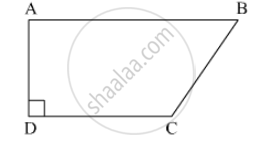Advertisements
Advertisements
प्रश्न
Find the area of the triangle whose vertices are (–8, 4), (–6, 6) and (–3, 9).
उत्तर
Given that, the vertices of triangles are (–8, 4), (–6, 6) and (–3, 9).
Let (x1, y1) `→` (−8, 4)
(x2, y2) `→` (−6, 6)
And (x3, y3) `→` (−3, 9)
We know that, the area of triangle with vertices
(x1, y1), (x2, y2) and (x3, y3)
Δ = `1/2[x_1(y_2 - y_3) + x_2(y_3 - y_1) + x_3(y_1 - y_2)]`
= `1/2[-8(6 - 9) - 6(9 - 4) + (-3)(4 - 6)]`
= `1/2[-8(-3) - 6(5) - 3(-2)]`
= `1/2(24 - 30 + 6)`
= `1/2(30 - 30)`
= `1/2(0)`
= 0
Hence, the required area of triangle is 0.
APPEARS IN
संबंधित प्रश्न
Find the area of the triangle formed by joining the mid-point of the sides of the triangle whose vertices are (0, –1), (2, 1) and (0, 3). Find the ratio of area of the triangle formed to the area of the given triangle.
median of a triangle divides it into two triangles of equal areas. Verify this result for ΔABC whose vertices are A (4, - 6), B (3, - 2) and C (5, 2).
Find the area of a triangle whose vertices are
`(at_1^2,2at_1),(at_2^2,2at_2)` and `(at_3^2,2at_3)`
prove that the points A (7, 10), B(-2, 5) and C(3, -4) are the vertices of an isosceles right triangle.
If G(-2, 1) is the centroid of a ΔABC and two of its vertices are A(1, -6) and B(-5, 2) , find the third vertex of the triangle.
If the points P(-3, 9), Q(a, b) and R(4, -5) are collinear and a+b=1, find the value of a and b.
In ☐ABCD, l(AB) = 13 cm, l(DC) = 9 cm, l(AD) = 8 cm, find the area of ☐ABCD.

The points (1,1), (-2, 7) and (3, -3) are ______.
The area of a trapezium is 475 cm2 and the height is 19 cm. Find the lengths of its two parallel sides if one side is 4 cm greater than the other.
Find the missing value:
| Base | Height | Area of parallelogram |
| ______ | 8.4 cm | 48.72 cm2 |
